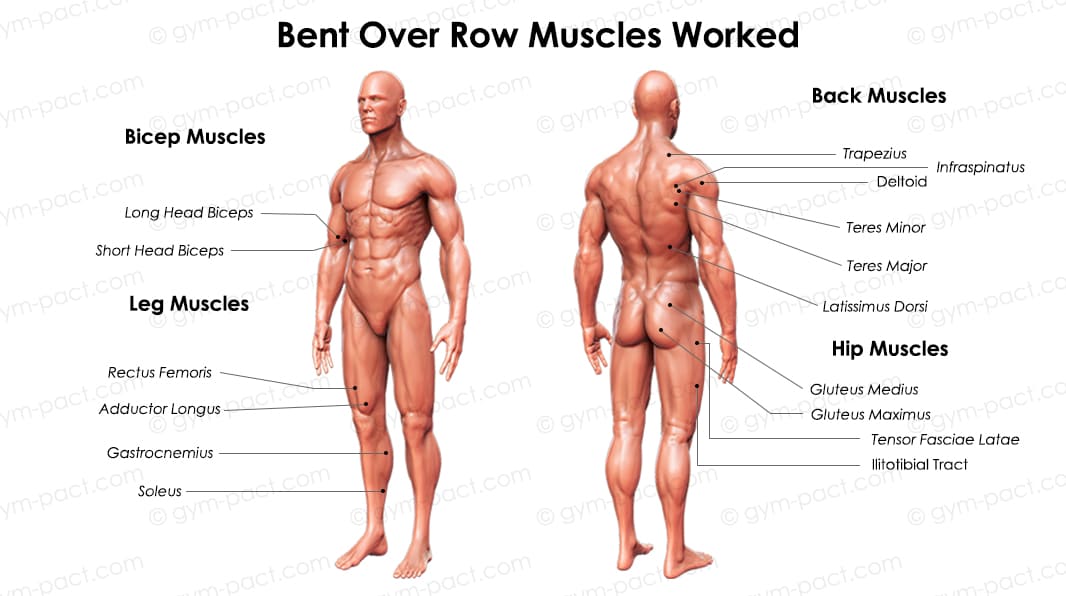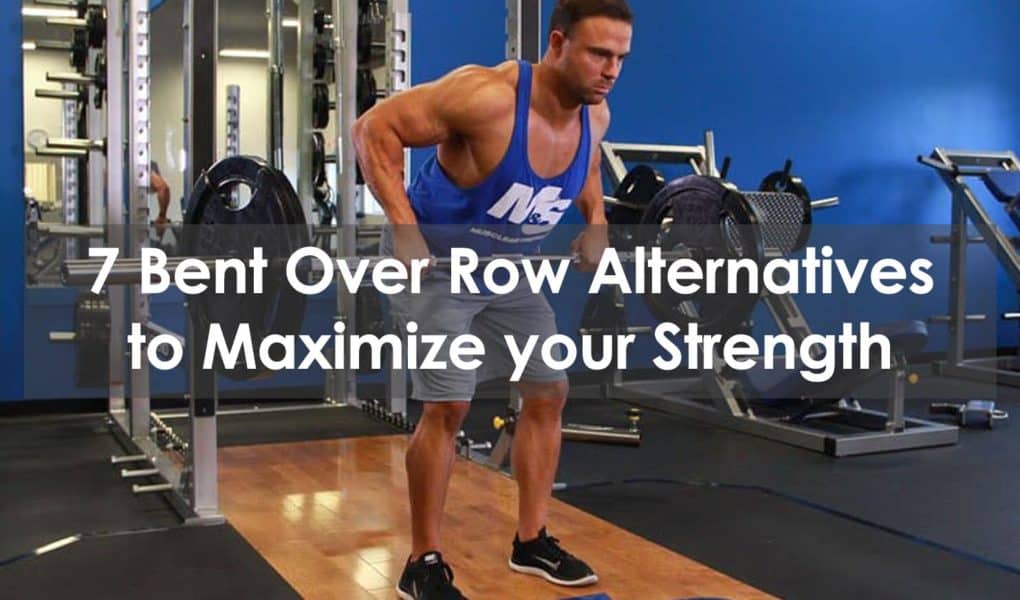What is the bent over row?
If you ask most gym-goers the most effective movement for building a massive upper body, they’ll more than likely give you two exercises, the beloved bench press or the military press.
But in fact, I would argue the most effective and significant exercise you can do is the bent-over row. But what is the best bent over row alternative? Are there any? Well, yes, there are.
The cable row or different movements such as the one-arm row is classified as “pulling” actions. The vast majority of quality trainers and coaches will implement both “pushing and pulling movements” into their client routines. However, most of the time, the pushing movements far outnumber the pulling.
Benefits of the bent over row
The barbell bent over row offers several benefits including increased strength in the posterior chain, upper back, hips, and legs. These pull workouts also promote stability, range of motion, and importantly help reduce the chance of injury.
Muscles worked

Primarily targeting the muscle groups in the upper back, these exercises also work the hips, legs, biceps, lats, and core, making this one of the best exercises to implement for overall upper back strength.
Common mistakes to avoid
Some of the most common mistakes to avoid are going too heavy, using poor form, not warming up before lifting, and performing too many reps. Far too often athletes try to lift as heavy as they can without using proper form, this problem leads to potential injury, particularly in the rib cage, and valuable time away from the gym.
If this sounds like you, I recommend you start training the pulling movements more often and trying these bent over row alternatives.
Best Bent Over Row Alternatives
1. Reverse Grip Row With Barbell
The reverse grip barbell row is recognized as one of the best compound exercise movements you can perform for developing thickness and strength in the back. It targets the lower lats, back, and to a certain degree, the biceps (bonus) and is seen as an excellent T bar row alternative.
Many experienced athletes use the reverse grip barbell row as they feel it provides a better overall back workout, as it hits the lats more effectively than the traditional cable rows.
Equipment:
Primary Muscles:
Back, Lat, Biceps
How to perform:
- Grab the bar with an underhand grip and set up as you would perform a traditional bent over row.
- Both hands and feet should be shoulder-width apart to form a strong foundation for the movement.
- Bend over until you reach 45 degrees, with your arms hanging down by your side.
- Slowly pull the bar toward your midsection, keep your back straight, making sure to engage your core throughout the entire movement.
- Lower the bar in a controlled fashion.
- Repeat.
Coaches Tip:
Be absolutely certain to keep your core tight during the barbell row as this will prevent injury and chronic pain to the back and neck.
Sets and Reps:
3 sets of 8-12 reps
2. Inverted Row
An exercise that is rarely used by people. The inverted row truly is one of the most effective movements for training the back and serves as a great cable row machine alternative. All you need is a bar of any kind fixed at waist height to perform this activity.
Because this exercise is classified as a bodyweight movement, it provides a fantastic workout to people of all fitness levels.
Equipment:
Straight bar at waist height
Primary Muscles:
Back, Shoulders, Lats, Biceps, Core
How to perform:
- Find a bar that is waist height. It could be anything from the bar on a smith machine to a random stable bar you’ve found outside at home.
- Under the bar, use the overhand grip to grab the bar shoulder-width apart.
- With your arms extended and your feet straight, slowly pull yourself up until your chest touches the bar, squeezing your scapula for the full pump, and keep your back straight.
- While lowering, maintain a tight core, which helps you control the movement and prevent injury.
- Repeat.
Coaches Tip:
The inverted row is an excellent exercise for those who have limited equipment at home but still want the maximum benefits of a full back workout.
Sets and Reps:
3 sets of 8-12 reps
3. Lying Bench Rows
The lying dumbbell row provides you, the athlete, with several benefits, including better posture, increased shoulder mobility, and helps develop strength in the back and arms. Due to the numerous benefits the lying dumbbell exercise offers, it acts as another good cable row alternative.
Equipment:
Bench, Dumbbells
Primary Muscles:
Back, Shoulders, Biceps
How to perform:
- Grab a bench and set it to a position you feel comfortable. Some suggest 30 degrees but we’re all different in terms of body type and fitness level, which is why I recommend setting the bar where you feel comfortable.
- Lying face down, grab your dumbbells in both hands.
- Ensure your feet can touch the floor; this gives you a solid base to perform the exercise.
- Your arms should be hanging in a relaxed manner; now, slowly bring the dumbbells up towards the bench, making sure to keep your elbows tucked in tight at the top of the movement.
- Return to the starting position and repeat.
Coaches Tip:
This movement can be a bit tricky, so start with a weight that you can control easily, this helps you concentrate on proper form rather than the weight.
Sets and Reps:
3 sets of 12 reps
4. The TRX Row
When it comes to getting the most out of your training, the TRX is an incredible device you shouldn’t go without.
The TRX allows you to perform an array of exercises in varying positions, promoting strength in the primary muscles and developing the stability of secondary muscle groups responsible for things like posture, balance, and everyday activities such as standing and walking.
Equipment:
TRX
Primary Muscles:
Back, Lat, Core, Biceps
How to perform:
- Stand in an athletic position feet shoulder-width apart and facing the TRX anchor. The cables should be held in each hand.
- Slowly lower or “lean” backward with your palms in a pronated position.
- With a controlled motion, move your hands up over your head, simulating the shape of the letter “Y.’
- Pause at the top of the movement for a 2-second count before returning to the starting position.
- Repeat.
Coaches Tip:
An excellent activity before progressing to heavier, longer, and more intense training sessions. The TRX row promotes strength and mobility and should be incorporated into your weekly training program to maximize gains.
Sets and Reps:
3 sets of 8-12
5. T-Bar Row
The T- bar row is virtually identical to the weightlifting barbell row, with the primary difference being it’s a plate weighted machine version. The movement is also similar to that of the barbell row. However, as the weight follows a predetermined path, it minimizes the use of the stabilizing muscles.
Many argue the traditional barbell is a more effective exercise for overall back development, which I tend to agree with; however, the T- bar row has its advantages. One of them is that it emphasizes the workload on the lats allowing for a better pump.
Equipment:
T-bar platform
Primary Muscles:
Back, Shoulders, Biceps
How to perform:
- Stand with your feet shoulder-width apart in an athletic position, and your knees slightly bent.
- With an overhand grip that is shoulder-width apart, extend your arms and midsection towards the floor, stopping at 45 degrees.
- Slowly bring the weight up, focusing on the correct technique by keeping your elbows tight to your side and your core engaged.
- When you reach the top of the movement, squeeze your shoulder blades in and hold for a short pause.
- Return to the start position as always in a controlled manner to avoid injury.
- Repeat.
Coaches Tip:
This is a great seated cable row alternative, as it allows you to make the transition from free weights to isolation or machine exercises. If you don’t have access to a T-bar platform, a good hack is to secure the bar into the corner of a wall.
Sets and Reps:
3 sets of 8
6. One-Arm Dumbbell Row
The one-arm dumbbell row provides substantial intensity on the back mainly because this exercise is characterized as an isolation movement. The advantage of this exercise is that it develops your stabilizer muscles leading to better balance.
Another significant benefit of the one-arm dumbbell row is the amount of pressure it takes off the lower back by allowing you to lean your non-training arm on the bench providing additional support while performing the exercise.
Equipment:
Bench, Dumbbells
Primary Muscles:
Back, Lats, Biceps
Coaches Advice:
- Grab a bench and set it to a position you feel comfortable.
- Leaning with your non-working hand on the bench, grab your dumbbell in one hand.
- Ensure your feet are in a strong athletic position, this gives you a solid base to perform the exercise.
- Your arm should be hanging in a relaxed manner; now, slowly bring the dumbbell up towards the bench, making sure to keep your elbow tucked in tight.
- Return to the starting position.
- Repeat on the opposite side.
Coaches Tip:
This is an easy movement to master, meaning you can go heavy for maximum results.
Sets and Reps:
3 sets of 12 reps
Conclusion
As you can see by the number of different movements and exercises I’ve listed in this article, it’s critically important to train the back by implementing varying actions and modifying the number of weights, reps, and sets performed.
Doing this allows for increased size, strength, and mobility gains, which all help lead to a healthier longer life.
Increasing your back strength and mobility also helps lead to a reduction in injures, which halts development and keeps you out of action for months on end.
Remember, the most crucial muscle to engage while performing back exercise is the core. This is important as many back movements place a great deal of stress on the lower back and spine, so keeping the core fully engaged throughout the movement prevents injury from occurring.
Frequently Asked Questions
What Can I do Instead of Inverted Row?
There are numerous exercises that act as great effective alternatives to the inverted row. The back is a large muscle group and as such, you should consider using a variety of different movements on a regular basis. Varying the weight you use, your reps, sets, intensity, and regularity will all positively impact your back development.
Are Bent Over Rows Bad For Your Back?
The bent-over row receives a bad wrap from many trainers and gym-goers as an exercise that puts pressure on the lower back; however, if performed correctly and with the right coaching advice, the bent-over row provides an effective workout for overall back development. Keeping your core tight and engaged will also help provide a safe and stable base for you to execute the movement.
Which Grip Is Best For Bent Over Row?
Several grips can be used to perform the bent-over row, everything from the overhand grips to underhand grips. I recommend using the overhand grip as it takes stress off the wrists and forearms, especially for those who are new to weight training.
Why Are Bent Over Rows Good?
Bent over rows and weight training, offer an array of positive health benefits and increase strength in the muscle. They also promote stimulation and growth to the primary back muscles and utilize secondary muscle groups, such as the shoulders, arms, and core.
If coupled with a healthy eating plan and a stable cardio regime, the bent-over row is an excellent exercise, and I would recommend implementing it into your training now.







